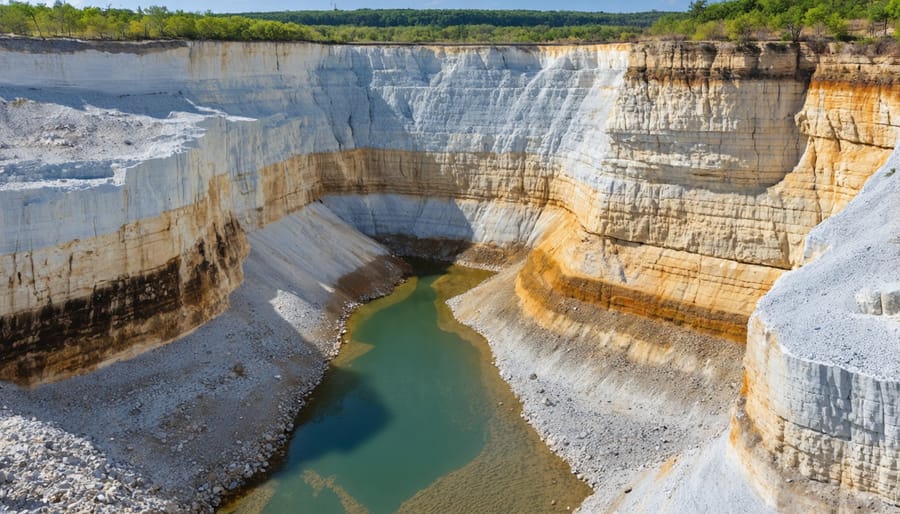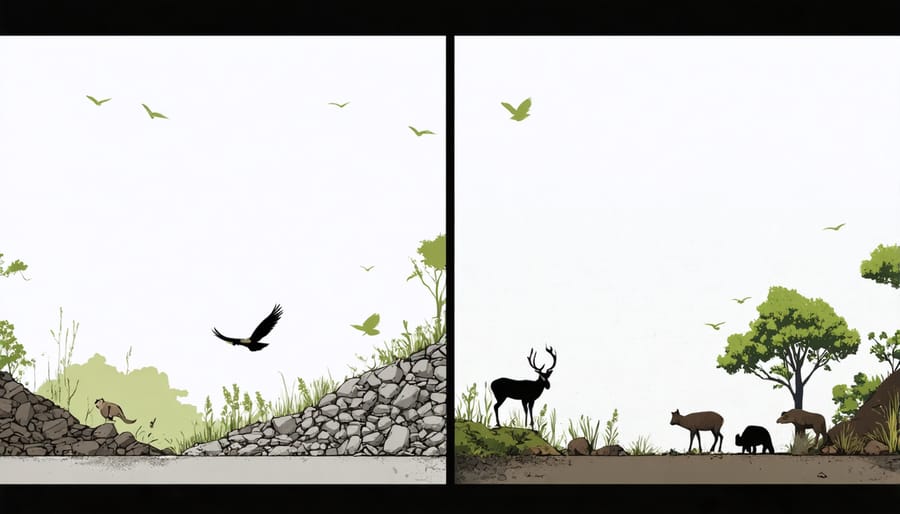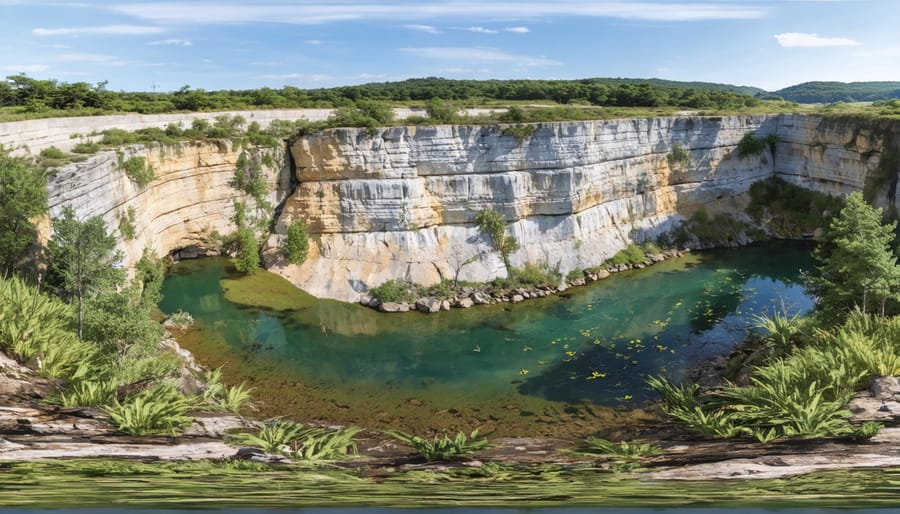Natural stone quarrying and biodiversity conservation represent a delicate yet achievable balance in modern industrial practices. While quarrying operations fundamentally alter landscapes, they create unique opportunities for ecological preservation and habitat creation. The extraction of ethically sourced natural stone has evolved to embrace biodiversity management, transforming former industrial sites into thriving ecosystems that support rare species and diverse wildlife populations.
Recent studies demonstrate that properly managed quarries can serve as sanctuaries for endangered species, providing distinctive microclimates and specialized habitats that mirror natural geological formations. From cliff-nesting birds to specialized invertebrates, these manufactured landscapes often harbor species that struggle to find suitable habitats in modern agricultural settings.
This integration of industrial activity and environmental stewardship represents a crucial advancement in sustainable resource management. By implementing carefully planned extraction methods, maintaining buffer zones, and executing progressive habitat restoration, the natural stone industry demonstrates how commercial operations can contribute positively to biodiversity conservation while meeting global demand for construction materials.
The Natural Stone Quarry Ecosystem
Unique Geological Features
Quarry operations create distinctive geological features that often become valuable habitats for diverse species. The vertical quarry walls, with their exposed rock faces and varying depths, mimic natural cliff environments that attract nesting birds, particularly raptors and specialized cliff-dwelling species. These walls provide secure breeding sites and shelter, similar to natural rock formations but with reduced human disturbance.
The formation of quarry pools through groundwater accumulation creates unique aquatic ecosystems. These bodies of water vary in depth and chemistry, supporting different types of aquatic life from amphibians to specialized invertebrates. The alkaline conditions often present in limestone quarries can foster rare plant species that thrive in calcium-rich environments.
Terraced quarry surfaces create microclimates at different elevations, each supporting distinct plant communities. The varied topography, including scree slopes and exposed bedrock, provides niches for specialized flora and their associated fauna. These features, combined with minimal human interference once quarrying ceases, allow nature to reclaim these spaces in unique ways, often resulting in greater biodiversity than the surrounding landscape.
Native Species Adaptation
Quarry environments, despite their industrial nature, often become surprising havens for wildlife adaptation and biodiversity. Several species have demonstrated remarkable abilities to thrive in these transformed landscapes. Peregrine falcons, known for their preference for steep cliff faces, frequently establish nesting sites on quarry walls, utilizing these artificial cliffs as effectively as natural ones.
Water-filled quarries attract various amphibian species, including the great crested newt and common toad, which find ideal breeding grounds in these artificial pools. The shallow waters and varied depths create perfect conditions for their life cycles. Meanwhile, bare rock faces and sparse vegetation areas become home to specialized plant species and rare butterflies that prefer these unique microclimates.
Little owls and kestrels often take advantage of the numerous crevices in quarry faces for nesting, while various bee species colonize exposed sand banks. These adaptations demonstrate nature’s resilience and ability to reclaim industrial spaces. Many quarry operators now actively manage their sites to support these species, creating dedicated wildlife zones and maintaining specific habitat features during and after extraction activities.


Active Conservation Strategies
Planned Extraction Patterns
Modern quarrying operations have evolved significantly to incorporate wildlife-friendly extraction patterns that maintain crucial ecological connectivity. By implementing sustainable stone practices, quarry operators now design their sites with dedicated wildlife corridors that allow animals to safely traverse the landscape.
These planned extraction patterns typically involve creating buffer zones around known migration routes and maintaining natural vegetation strips between active quarrying areas. Operators work closely with wildlife biologists to identify critical habitat areas and movement patterns before developing extraction plans. This collaborative approach ensures that quarrying activities don’t disrupt essential wildlife pathways.
Strategic phasing of extraction areas plays a vital role in preservation efforts. Instead of opening large areas simultaneously, quarriers work in smaller sections, allowing wildlife to adapt gradually to changes in their environment. This method also enables the progressive rehabilitation of completed sections, creating new habitat opportunities while extraction continues elsewhere.
Modern quarries incorporate features such as wildlife underpasses, vegetated overpasses, and stepping-stone habitats that facilitate animal movement. These engineered solutions help maintain genetic diversity among species by preventing population isolation. Water management systems are designed to create permanent water sources that benefit local wildlife while serving operational needs.
By carefully planning extraction patterns, quarry operators can maintain biodiversity while meeting market demands for natural stone. This approach demonstrates how industrial activities and wildlife conservation can successfully coexist, setting new standards for responsible resource extraction in the natural stone industry.
Buffer Zone Management
Buffer zones serve as vital transitional areas between active quarrying operations and surrounding natural habitats, playing a crucial role in biodiversity conservation. These carefully managed spaces act as protective shields, minimizing the impact of quarrying activities on local wildlife while creating additional habitats for various species.
Typically extending 50-200 meters around the quarry perimeter, buffer zones incorporate multiple vegetation layers, including native trees, shrubs, and groundcover. This graduated approach helps filter dust, reduce noise pollution, and provide wildlife corridors for local species to move safely between habitats.
Successful buffer zone management requires careful planning and continuous monitoring. Key strategies include:
– Maintaining native plant species that support local wildlife
– Creating wildlife corridors that connect fragmented habitats
– Installing settling ponds to manage water runoff
– Establishing noise and dust barriers through strategic planting
– Regular monitoring of wildlife movement and habitat use
Many quarry operators work with conservation experts to design and maintain these zones effectively. Regular environmental assessments help ensure the buffer zones continue to serve their protective function while supporting biodiversity.
Case studies have shown that well-managed buffer zones can actually enhance local biodiversity. For example, the creation of varied vegetation structures often attracts different bird species, while carefully designed water features provide habitats for amphibians and aquatic insects.
These protected areas demonstrate how industrial operations can coexist with nature through thoughtful planning and management. As the natural stone industry continues to embrace sustainable practices, buffer zones remain essential components of responsible quarrying operations.

Rehabilitation Success Stories
The Limestone Legacy
Abandoned limestone quarries have emerged as unexpected sanctuaries for biodiversity, transforming from industrial sites into thriving nature reserves. The Bradgate Quarry in Leicestershire, UK, stands as a prime example, where the steep cliff faces now provide nesting sites for peregrine falcons and rare wall flowers that flourish in the calcium-rich environment.
In Germany, the Messel Pit has evolved from a quarry into a UNESCO World Heritage site, preserving both geological history and supporting modern wildlife. The quarry’s alkaline pools attract diverse amphibian species, while its varied topography creates multiple microhabitats for specialized plants and insects.
The Quarry Gardens at Schuyler in Virginia demonstrates how thoughtful restoration can create a botanical paradise. This former soapstone quarry now hosts over 50 species of native trees and numerous wildflower varieties, proving that industrial sites can be successfully rewilded.
Perhaps most impressive is the National Stone Centre in Derbyshire, where six former quarries have been transformed into a geological park. The site combines educational value with conservation, featuring rare orchid species that have naturally colonized the limestone grasslands. These success stories highlight how the unique conditions created by quarrying can ultimately contribute to biodiversity conservation, turning industrial legacies into ecological assets.
Marble Metamorphosis
Abandoned marble quarries, once symbols of industrial extraction, have emerged as unexpected sanctuaries for biodiversity. These man-made landscapes create unique microclimates and ecological niches that support diverse plant and animal species. The vertical walls, water-filled basins, and varied terrain left behind by quarrying operations provide distinct habitats that mirror natural cliff formations and wetland environments.
The process of ecological succession in these sites is particularly fascinating. Pioneer species, such as lichens and mosses, gradually colonize the exposed rock faces, creating conditions for more complex plant communities to establish. The quarry floors often collect rainwater, forming seasonal or permanent pools that attract amphibians and waterfowl. These water features, combined with the sheltered environment of quarry walls, create ideal conditions for numerous species to thrive.
Several European marble quarries have become model examples of natural rehabilitation. In Tuscany, Italy, abandoned Carrara marble quarries now host rare orchid species and provide nesting sites for peregrine falcons. Similarly, in Vermont, USA, former marble quarries have transformed into vital wetland habitats supporting diverse ecosystems of native flora and fauna.
This natural transformation demonstrates how industrial sites can evolve into valuable ecological assets, contributing to local biodiversity conservation while preserving geological heritage. These sites often become living laboratories for studying ecosystem development and species adaptation in post-industrial landscapes.
Industry Best Practices
Monitoring Programs
Effective monitoring programs form the backbone of quarry wildlife conservation efforts, combining traditional observation methods with cutting-edge technology. Quarry operators employ various tracking techniques, including motion-sensitive cameras, GPS collars, and regular biodiversity surveys to monitor species populations and movements within their sites.
These monitoring systems help identify critical habitats, breeding areas, and migration patterns of local wildlife. Regular species counts and habitat assessments are conducted by trained environmental specialists, often in partnership with local wildlife organizations and universities. This data collection provides valuable insights into how quarrying activities impact local ecosystems and helps operators adjust their practices accordingly.
Many quarries maintain detailed databases of observed species, tracking population trends over time. This information proves invaluable for developing and adjusting conservation strategies. Advanced GIS mapping technology allows operators to create detailed habitat maps, identifying sensitive areas that require special protection during extraction activities.
Water quality monitoring is another crucial component, as many quarry sites develop into important wetland habitats. Regular testing ensures these water bodies remain suitable for aquatic species and visiting wildlife. Additionally, noise and dust monitoring help operators understand and minimize their impact on sensitive species.
Success metrics are carefully tracked, including species diversity indices, population numbers, and breeding success rates. This data-driven approach enables quarry operators to demonstrate their conservation effectiveness and make informed decisions about future site management.
Sustainable Extraction Guidelines
Modern quarrying operations have evolved significantly to embrace wildlife-friendly practices while maintaining productive extraction. These guidelines focus on minimizing environmental impact through carefully planned extraction zones and buffer areas that protect existing wildlife corridors. Effective water management in quarries plays a crucial role, ensuring both operational efficiency and habitat preservation.
Industry leaders now implement progressive rehabilitation techniques, restoring quarried areas while operations continue in other sections. This approach creates a dynamic landscape where wildlife can thrive alongside active extraction. Key practices include maintaining native vegetation strips, creating artificial wetlands, and establishing wildlife crossings.
Quarry operators must conduct regular biodiversity surveys and adjust their extraction patterns based on seasonal wildlife movements. The implementation of sustainable stone certification programs ensures compliance with these guidelines while providing transparency to consumers.
Success metrics include monitoring species populations, maintaining water quality, and documenting habitat restoration progress. Advanced technology, such as drone surveys and GPS tracking, helps operators maintain precise extraction boundaries while protecting sensitive ecological areas. These guidelines demonstrate that responsible quarrying can actually enhance local biodiversity through careful planning and ongoing environmental stewardship.
Conservation efforts in quarry biodiversity have demonstrated remarkable success in recent years, proving that industrial activities and environmental protection can coexist harmoniously. Through carefully planned rehabilitation programs and ongoing wildlife monitoring, many quarry sites have transformed into thriving ecosystems that support diverse species of flora and fauna.
The positive impact of these conservation initiatives extends beyond the immediate quarry boundaries, creating wildlife corridors and stepping stones that connect fragmented habitats. Success stories from various global locations show how abandoned quarries have become sanctuaries for rare species and important stopover points for migratory birds.
Looking ahead, the future of quarry conservation appears promising. Advanced technologies and improved understanding of ecosystem dynamics are enabling more effective rehabilitation strategies. The stone industry continues to develop innovative approaches to minimize environmental impact during active operations while maximizing biodiversity potential in post-extraction landscapes.
The commitment to conservation from both industry stakeholders and environmental organizations has established a sustainable framework for future quarrying activities. This collaborative approach ensures that natural stone extraction can continue to meet construction demands while contributing positively to local biodiversity. As we move forward, these conservation practices will likely become even more sophisticated, setting new standards for industrial-environmental partnerships and demonstrating how commercial activities can actively support nature conservation goals.










